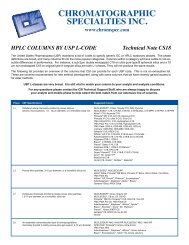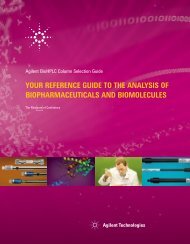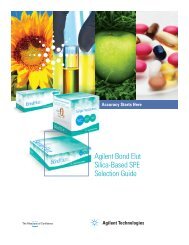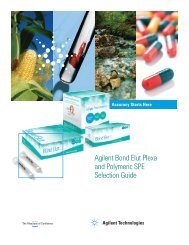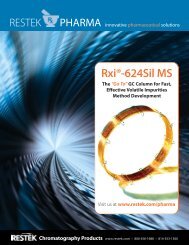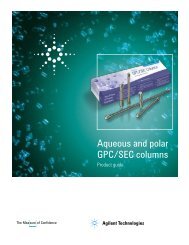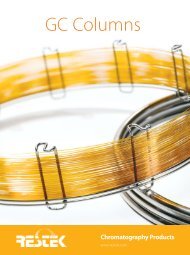Optimizing the Analysis of Volatile Organic Compounds
Optimizing the Analysis of Volatile Organic Compounds
Optimizing the Analysis of Volatile Organic Compounds
Create successful ePaper yourself
Turn your PDF publications into a flip-book with our unique Google optimized e-Paper software.
34<br />
Figure 35.<br />
The quantification ion for<br />
chlorobenzene-d5 can be changed<br />
from ion 117 to ion 82, to eliminate <strong>the</strong><br />
need for chromatographic resolution from<br />
1,1,1,2-tetrachloroethane.<br />
Ion 117<br />
Ion 82<br />
Figure 36.<br />
A slower oven temperature program<br />
eliminates <strong>the</strong> need to change <strong>the</strong> internal<br />
standard or <strong>the</strong> quantification ion.<br />
ion 117<br />
Ion 131<br />
chlorobenzene-d5 }chlorobenzene-d5<br />
ethylbenzene<br />
chlorobenzene<br />
1,1,1,2-tetrachloroe<strong>the</strong>ne<br />
ion 117<br />
Extracted ion chromatogram (black)<br />
overlayed on total ion chromatogram (green)<br />
www.restekcorp.com<br />
Identifying Target Analytes<br />
Qualitative identification <strong>of</strong> a target compound is based on retention time (± 0.06 minutes) and<br />
on comparison <strong>of</strong> <strong>the</strong> sample mass spectrum to a reference mass spectrum. <strong>Compounds</strong> are<br />
identified from three ions <strong>of</strong> <strong>the</strong> greatest intensity. The quantification ion, usually <strong>the</strong> highest<br />
m/z fragment, is used for determining <strong>the</strong> concentration <strong>of</strong> a particular analyte. When using<br />
any column for GC/MS, attention must be given to coeluting compounds to determine if<br />
acceptable quantification ions can be found. It is important that <strong>the</strong>re be no coelution between<br />
compounds sharing ions used for quantification. As long as unique ions can be selected for<br />
quantifying compounds that share retention time, chromatographic coelution is acceptable.<br />
Reducing analysis time without carefully checking for coelutions can lead to problems. For<br />
example, internal standard chlorobenzene-d5 and analyte 1,1,1,2-tetrachloroethane, which<br />
share quantification ion 117, can coelute from a “VMS,” “624,” or “VRX” stationary phase.<br />
Many laboratories eliminate <strong>the</strong> need for chromatographic resolution by changing <strong>the</strong> quantification<br />
ion for chlorobenzene-d5 from 117 to 82 (Figure 35). An alternative solution is to<br />
replace chlorobenzene-d5 with ano<strong>the</strong>r internal standard that elutes in <strong>the</strong> same region <strong>of</strong> <strong>the</strong><br />
chromatogram, such as 4-brom<strong>of</strong>luorobenzene. In performance-based measurement systems<br />
(PBMS), surrogates and internal standards may be changed, as long as <strong>the</strong> analyst can show<br />
that <strong>the</strong> performance will be equivalent or better. Auditors for state or local regulatory agencies<br />
might not allow <strong>the</strong>se changes, however. An additional option, <strong>the</strong> suggested surrogates can be<br />
used and <strong>the</strong> analysis performed using a slower GC oven temperature program that resolves<br />
<strong>the</strong> coelution (Figure 36). This option eliminates <strong>the</strong> need to change ei<strong>the</strong>r <strong>the</strong> internal standard<br />
or <strong>the</strong> quantification ion, but prolongs analysis time. An analysis time <strong>of</strong> less than 10 minutes,<br />
with chromatographic resolution <strong>of</strong> <strong>the</strong>se compounds, is possible with a 20m x 0.18mm x<br />
1.0µm df Rtx ® -VMS column (see Application section, page 51).<br />
Identifying Non-Target Analytes<br />
For samples containing analytes that do not match retention time and/or mass spectra for <strong>the</strong><br />
target compounds, a library search can be used in an attempt to match <strong>the</strong> unknown spectra<br />
with known spectra. Unknown compounds in <strong>the</strong> sample, referred to as tentatively identified<br />
compounds (TICs), should be reported only as estimates.<br />
Mass Spectral Clues for Identifying TICs: The MS provides three valuable clues to identifying<br />
TICs: parent ion, isotopic composition, and common fragmentation ions. The parent<br />
ion (also known as <strong>the</strong> molecular weight ion) is <strong>the</strong> ionized form <strong>of</strong> <strong>the</strong> neutral compound,<br />
but not all compounds are stable enough to produce a molecular weight ion. Most environmental<br />
contaminants, except compounds that contain nitrogen, will have an even number<br />
mass for a parent ion. The parent ion reveals information about <strong>the</strong> elemental composition<br />
and <strong>the</strong> distribution <strong>of</strong> isotopes. The term “isotope” is used to describe atoms <strong>of</strong> an element<br />
with differing numbers <strong>of</strong> neutrons. Most elements have isotopes in a particular distribution<br />
to each o<strong>the</strong>r. For example, carbon occurs primarily in two forms, 12C and 13C. 13C is at an<br />
abundance <strong>of</strong> 1.1% relative to 12C. 12 This information can contribute to determining <strong>the</strong> number<br />
<strong>of</strong> carbons present in <strong>the</strong> fragmented ion. Carbon is considered an A+1 element because<br />
its isotopes vary by 1amu. <strong>Compounds</strong> such as oxygen, sulfur, silicon, chlorine, and bromine<br />
are A+2 elements because <strong>the</strong>ir isotopes vary by 2amu or more (Figure 37, page 35).<br />
Fragmentation ions also can <strong>of</strong>fer clues to compound composition (Table V).<br />
Leak-Free Column/MS Installation Using an Injection Port Connection<br />
The most common problem associated with volatiles analyses by GC/MS is <strong>the</strong> presence <strong>of</strong><br />
leaks. The following procedure will help ensure optimum performance. Do not use this procedure<br />
with columns with IDs larger than 0.25mm, because <strong>the</strong> amount <strong>of</strong> oxygen that<br />
would be introduced into <strong>the</strong> MS source during <strong>the</strong> last step will oxidize <strong>the</strong> metal parts and<br />
reduce sensitivity.<br />
12. F.W. McLafferty and F. Turecek. Interpretation <strong>of</strong> Mass Spectra, University Science Books, Mill<br />
Valley, 4th edition, 1993, pp. 283-291.





